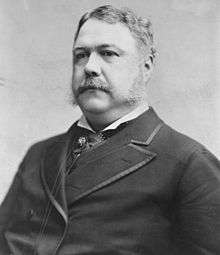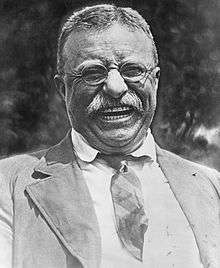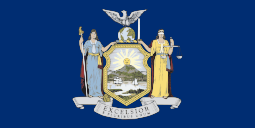New York Republican State Committee
The New York Republican State Committee established 1855, is an affiliate of the United States Republican Party (GOP). Its headquarters are in Albany, New York.[1] The purpose of the committee is to nominate Republican candidates for election to New York state and federal political roles.[2] It also formulates Republican Party policy on New York State issues and assists its nominees in their election campaigns.
New York State Republican Committee | |
|---|---|
 | |
| Chairperson | Nick Langworthy |
| Assembly Leadership | William Barclay (Minority Leader) |
| Senate Leadership | John J. Flanagan (Minority Leader) |
| Founded | 1855 |
| Headquarters | 315 State Street Albany, NY 12210 |
| Youth wing | The New York Young Republican Club |
| Ideology | Centrism Fiscal conservatism Green conservatism |
| Political position | Center to center-right |
| National affiliation | Republican Party |
| Colors | Red |
| New York State Assembly | 43 / 150 |
| New York State Senate | 22 / 63 |
| Statewide Executive Offices | 0 / 4 |
| New York City Council | 3 / 51 |
| U.S. House of Representatives (New York) | 6 / 27 |
| U.S. Senate (New York) | 0 / 2 |
| Website | |
| www | |
History
The New York Republican State Committee was established in 1855, one year after the founding of the "Republican Party" by William H. Seward and Thurlow Weed.[2] Initially, the committee met every three years to plan the Republican National Convention and it occasionally met during the election campaigning periods.
The establishment of the Republican Party in New York in the 1850s was a difficult task. At the time, the nativist American Party, (a party evolved from the Know Nothing Party) was active. However, the committee presented nominees from a party with well-recognized members, a defined set of principles, stable, powerful, well-known leaders and a well established structure. The committees nominees were first successful in 1856.[3] Around 1894, when immigration was at its peak, the New York State Constitution created a clause which caused Upstate New York to have reappointed districts so that there would be more votes per district, which gave native New Yorkers more votes than immigrants. It was not until 1974 that the Supreme Court of the United States deemed the clause to unconstitutional. That created a turmoil in the politics of New York because the Republican Party lost its hold on the state legislature.[2] Since 1959, Nelson Rockefeller (1959–73) and George Pataki (1995–2006) were the only two major Republican governors of New York.
Until 1911, the New York Republican State Committee nominated its candidates through a primary or caucus system, which meant the average voter had very little input as to who would be their choice for the state and federal offices. That system was taken out of practice after the passing of the Direct Primary Law in 1911, which allowed for more input from those present at the primary.[2]
Organization
| Office | Office-holder |
|---|---|
| Chairman | Nick Langworthy |
| First Vice Chairman | Bill Reilich |
| Secretary | Rebecca Marino |
| Treasurer | John Riedman |
| Chief of Staff | Tony Casale |
| National Committeewoman | Jennifer Saul |
| National Committeeman | Lawrence Kadish |
County committee
New York State has 62 counties. Every two years, in each county, Republicans elect a "Republican County Committee". The chair of each county committee is the face of the Republican Party in that county. New York also has 150 Assembly districts. Republicans elect one male and one female leader in each district. The district leaders form the executive committee of the respective county committee. The chair and the executive committee seek new party members; control local finances; find candidates to run for public office and choose the nominee (unless both candidates have petitioned enough signatures to trigger a primary).[2]
State committee
The New York State Republican State Committee is composed of one male and one female representative from each Assembly District. Before each statewide election, the committee organises a party convention and chooses candidates for offices of the state. 60% of the committee's vote is needed to win the party's nomination. If no candidate wins 60% of the committee's vote, the candidates with more than 25 percent of the committee's vote compete in a "primary" which is held in the month of September. A candidate with less than 25 percent of the committee's vote may compete in the "primary" if they have a petition of support of greater than 15000 voters.
The State Committee also elects one National Committeewoman and one National Committeeman to represent the state committee to the Republican National Committee in Washington, D.C. The current National Committee members are Jennifer Saul, a Republican fundraiser and former chairwoman of the New York County Republican Committee, and Lawrence Kadish, a real estate developer from downstate New York.
Current elected officials
The New York Republican Party holds 22 out of the 63 seats in the New York State Senate and 5 of the state's 27 U.S. House seats.
Members of Congress
U.S. Senate
- None
Both of New York's U.S. Senate seats have been held by Democrats since 1998. Al D'Amato was the last Republican to represent New York in the U.S. Senate. First elected in 1980, D'Amato lost his bid for a fourth term in 1998 to Chuck Schumer who has held the seat since.
U.S. House of Representatives
Out of the 27 seats New York is apportioned in the U.S. House of Representatives, 6 are held by Republicans:
Statewide offices
- None
New York has not elected any GOP candidates to statewide office since 2002, when George Pataki was re-elected as governor. In 2006, Pataki opted not to seek re-election to a fourth term. Former state assemblyman John Faso ran as the Republican nominee in the 2006 election and was subsequently defeated by Democratic challenger Eliot Spitzer.
List of chairpersons


.jpg)
| Chair | Tenure | Hometown while serving |
|---|---|---|
| Edwin D. Morgan | 1856–1858 1874–1875 | Manhattan |
| James Kelly | 1858–1860 | Manhattan |
| Simeon Draper | 1860–1862 | Manhattan |
| Henry R. Low | 1862–1863 | Monticello |
| Charles Jones | 1863–1865 | Brooklyn |
| William R. Stewart | 1865–1866 | Manhattan |
| Hamilton Harris | 1866–1870 | Albany |
| Alonzo B. Cornell | 1870–1874 1875–1877 1878–1879 | Manhattan |
| John F. Smyth | 1877–1878 1882–1883 | Albany |
| Chester A. Arthur | 1879–1881 | Manhattan |
| B. Platt Carpenter | 1881–1882 | Stanford |
| James D. Warren | 1883–1885 | Buffalo |
| Chester S. Cole | 1885–1887 | Corning |
| Cornelius N. Bliss | 1887–1889 | Manhattan |
| John N. Knapp | 1889–1891 | Auburn |
| William H. Brookfield | September 1891 – September 1894 | |
| Charles W. Hackett | September 1894 – April 1898 | Utica |
| Benjamin B. Odell Jr. | May 1898 – November 1900 April 1904 – September 1906 | Newburgh |
| George W. Dunn | November 1900 – April 1904 | Binghamton |
| Timothy L. Woodruff | September 1906 – October 1910 | Brooklyn |
| Ezra P. Prentice | October 1910 – January 1911 | Manhattan |
| William Barnes Jr. | January 1911 – September 1914 | Albany |
| Frederick C. Tanner | October 1914 – January 1917 | Manhattan |
| George A. Glynn | January 1917 – September 1922 | Watertown |
| George K. Morris | September 1922 – August 1928 | Amsterdam |
| H. Edmund Machold | August 1928 – June 1929 | Watertown |
| William J. Maier | June 1929 – November 1930 | Seneca Falls |
| W. Kingsland Macy | December 1930 – September 1934 | Islip |
| Melvin C. Eaton | September 1934 – November 1936 | Norwich |
| William S. Murray | January 1937 – April 1940 | Utica |
| Edwin F. Jaeckle | April 1940 – November 1944 | Buffalo |
| Glen R. Bedenkapp | January 1945 – February 1949 | Lewiston |
| William L. Pfeiffer | 1949 – September 1953 | Buffalo |
| Dean P. Taylor | September 1953 – September 1954 | Troy |
| L. Judson Morhouse | September 1954 – January 1963 | Ticonderoga |
| Fred A. Young | April 1963 – January 1965 | Lowville |
| Carl Spad | February 1965 – May 1967 | White Plains |
| Charles A. Schoeneck Jr. | May 1967 – April 1969 | Syracuse |
| Charles T. Lanigan | 1969 – November 1972 | Utica |
| Richard M. Rosenbaum | November 1972 – June 1977 | Rochester |
| Bernard M. Kilbourn | June 1977 – 1981 | Utica |
| George L. Clark Jr. | March 1981 – July 1985 | Brooklyn |
| Anthony J. Colavita | September 19, 1985 – June 22, 1989 | Westchester County |
| J. Patrick Barrett | June 22, 1989 – January 14, 1991 | Syracuse |
| William D. Powers | January 14, 1991 – March 8, 2001 | Rensselaer County |
| Alexander F. Treadwell | March 8, 2001 – November 15, 2004 | Westport |
| Stephen J. Minarik | November 15, 2004 – November 15, 2006 | Webster |
| Joseph N. Mondello | November 15, 2006 – September 29, 2009 | Hempstead |
| Edward F. Cox | September 29, 2009 – July 1, 2019 | Manhattan |
| Nick Langworthy | July 1, 2019 – present | Amherst |
See also
References
- Archived May 14, 2010, at the Wayback Machine
- "New York Republican State Committee". Library.albany.edu. Retrieved 2016-01-07.
- Silbey, Joel (1985). The Partisan Imperative New York: Oxford University Press
